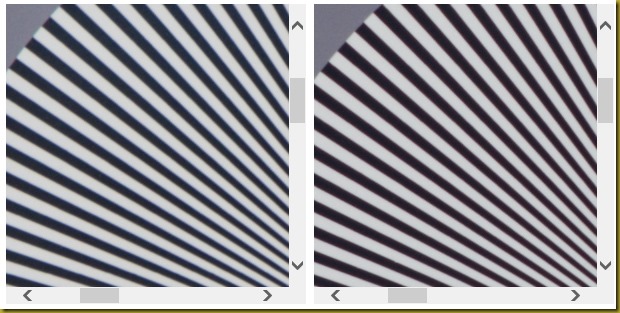To zoom or not to zoom—the ‘fixed length’ conundrum
This is an age old problem for photographers. Whether to use a zoom lens or a fixed length lens.
With a zoom lens you get the flexibility of being able to easily change the focal length of the lens with a twist of the zoom collar, or for slide zooms by sliding the barrel.
With a fixed length lens you are stuck with the focal length of the lens. The only way of ‘zooming’ in or out is to either change where you are taking the picture from or change lenses.
The problem being that—for any given price bracket—fixed length lenses almost always have the better resolution/image quality.
Just to give you some idea of the ‘average’ difference between a mid-range zoom and a mid-range fixed length lens, in the picture below the test shot on the left is from an 18 – 135 zoom at the 85mm length taken at f8. The shot on right is from a fixed length 85mm lens also at f8.
Now for most folk the difference is nothing they would be concerned about, but for us ‘serious’ takers of pictures with actual cameras (as opposed to a camera phone) the above has been the basis of many millions of hours of discussions over the years.
A mid-range 18 –135mm zoom lens is about $600 and a decent 85mm fixed length lens is about $500. But with the zoom you get to use any focal length from 18mm through to 135mm. It’s like having four or five or more lens but they are all in the one and you don’t have to keep changing lenses to change focal length. So is that worth the loss in image quality? This is the question?
In the ‘old’ days there was no choice. All lenses were fixed length. You had to change lenses to change focal length. This was probably why the interchangeable lens camera was originally invented.
Then along came useful zoom lenses in the early 1960s, and with these first zooms there was still really no choice. If you wanted crisp pictures you had to use fixed length lenses because early zooms were about ten times worse than the example shown above. Back then serious photographers did not even consider using zoom lenses, except maybe for playing around and seeing just how bad the pictures were that they took were.
But with computer designs, modern lens manufacturing, and precision assembly that we have today the zooms are much better. However, price-range for price-range, there is still a difference in image quality. Enough of a difference for really serious professional photographers making their living from taking pictures to stick with fixed length lenses.
Five or six years ago the saying used to be something like “you can’t fix up bad image quality in Photoshop”. But this is not totally true today.
I promise you that the following picture is the same picture as above but I have used Photoshop Elements to firstly apply 10:10 demisting sharpen and then 30 percent of 1.8 pixel sharpening ONLY to the left hand panel. Nothing has been done to the right panel.
Now the zoom lens shot on the left isn’t looking too shabby.
So maybe now, in 2014, there really is no reason to fear the image quality of zooms; certainly not higher end zooms anyway. Although it does mean you need to do some photo-finishing in something like Photoshop Elements but I would expect all serious amateur takers of pictures are doing this anyway.



